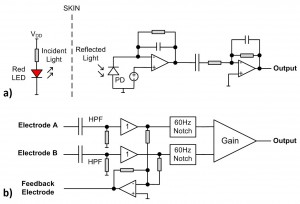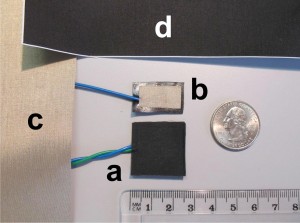A Wearable Vital Signs Monitor
Vital signs such as heart rate, blood pressure, cardiac output, blood oxygenation, respiratory rate, and body temperature are necessary in determining the overall health of a patient. Continuous monitoring of these vital signs can help identify a patient’s risks for stroke, heart attack, heart failure, arterial aneurysm, and renal failure [1].
We propose an integrated, wearable, vital signs monitor that senses the above vital signs. To do this, we measure signals such as the photoplethysmogram (PPG), the electrocardiogram (ECG), and the ballistocardiogram (BCG). The PPG is the measurement of blood volume under the skin using optical illumination. The PPG offers information such as heart rate and blood oxygenation, and it can be obtained using the circuit in Figure 1a. The ECG is the measurement of electrical activity from the heart and offers information such as heart condition, heart rate, blood pressure (when coupled with other signals), and respiratory rate. The ECG can be obtained using the circuit in Figure 1b. The BCG is the measure of the body’s reaction force to the blood expelled by the heart and offers information about heart rate, cardiac output, and respiratory rate. The BCG can be also be measured by the circuit in Figure 1b.
To make the monitor wearable, the electrodes must be small, comfortable, and gel-less to avoid skin irritation. We investigate capacitive and dry electrodes made of wearable fabric materials, as shown in Figure 2. Mechanical designs are also needed to securely attach the device to the body while minimizing motion artifacts and the use of skin adhesives.
- Figure 1: a) The PPG front-end circuit and b) the ECG/BCG front-end circuit.
- Figure 2: a) A capacitive electrode, b) a dry electrode, c) conductive fabric, and d) nylon insulating fabric.
References
- S. D. Pierdomenico, M. Di Nicola, A. L. Esposito, et al., “Prognostic value of different indices of blood pressure variability in hypertensive patients,” American Journal of Hypertension, June 2009, pp. 842-847. [↩]

